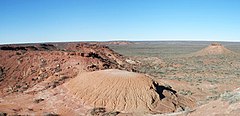| Lohan Cura Formation | |
|---|---|
| Stratigraphic range: Late Aptian-Albian ~ | |
 | |
| Type | Geological formation |
| Sub-units | Puesto Quiroga & Cullín Grande Members |
| Underlies | Río Limay Subgroup Candeleros Formation |
| Overlies | Mendoza Group La Amarga, Agrio & Bajada Colorada Formations |
| Thickness | 177 m (581 ft) |
| Lithology | |
| Primary | Mudstone, siltstone, sandstone |
| Other | Claystone |
| Location | |
| Coordinates | 39°36′S 69°24′W / 39.6°S 69.4°W |
| Approximate paleocoordinates | 43°42′S 39°24′W / 43.7°S 39.4°W |
| Region | Río Negro Province, Mendoza Province, Neuquén Province |
| Country | Argentina |
| Extent | Neuquén Basin |
| Type section | |
| Named by | Leanza & Hugo |
| Year defined | 1995 |
The Lohan Cura Formation is a geologic formation with outcrops in the Argentine provinces of Río Negro, Neuquén, and Mendoza. It is the second oldest Cretaceous terrestrial formation in the Neuquén Basin.
The Lohan Cura Formation unconformably overlies the terrestrial La Amarga Formation. In some places it also overlies the older marine Agrio and Bajada Colorada Formations of the Mendoza Group through the same Middle Miranican unconformity. It is in turn overlain by the Candeleros Formation of the Neuquén Group, separated by the Main Miranican unconformity. The Lohan Cura correlates with the Rayoso Formation in some areas.[1]
- ^ Leanza et al., 2004, p.66
